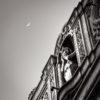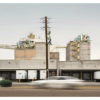In my previous post I attempted to convince you that a simple, well-designed composition is more elegant than primitive. In this post I will use one of my own photographs as a case study to examine the complexity and infinite potential in what some may consider to be a simple or even obvious composition. I’ll be referring to my image, The End and discussing how I processed the scene to arrive at my final composition. I made this image on the Southern shore of Lake Erie near Cleveland, Ohio in the summer of 2015.

Working The Scene
First of all, it’s worth noting that there were five of these decaying concrete piers spaced out about ten yards from each other along the beach. I walked the beach and selected this one for it’s particular characteristics: length, degree of decay, amount of debris in the surrounding water, etc.
At first you might think, “He put the pier in the middle, an obvious choice.” Fair enough. I do love symmetry. But I hope to show you that there’s a lot more happening here than simply centering the structure in the middle of the frame.
The more you simplify an image, the more important each element becomes and the more the relationships between each element are emphasized. When considering the immensity of detail and texture present in the decaying concrete, I knew that capturing it along with the textures of the stormy clouds and every detail of every ripple in the water would be too chaotic for my taste. I knew right away that this image needed to be captured with a slow shutter speed to help clean it up. Long exposure photography is all the rage right now but I have no interest in trends or gimmicks. I use long exposures intentionally to abstract, simplify and create space. Thus, my first composition decision was made.
Now, I just needed to organize the rest of the scene. Here are some questions that ran through my mind:
- Do I hint at a foreground and show the details of the sandy beach, or just let the pier float in the infinite, ethereal mist?
- How much of the pier should I show? How far into the image do I want to draw the viewer?
- What elevation should I set my tripod to? A high camera angle elongates the pier and shows less perspective distortion while a lower angle foreshortens the pier, changing the proportions of the near and far ends and exaggerating the converging lines.
- What focal length should I use? This also affects perspective distortion and near/far proportional relationships.
- Where do I place the horizon in the frame? How much sky should be present? How much space needs to be between the horizon and the end of the pier to avoid crowding it?
- What things might stand out as a natural focal point? I kind of like the one remaining unbroken concrete slab, but I need to investigate whether it is a point of interest or a potential distraction.
- What other nonessential elements need to be obscured?
Each of these questions affected how I worked the scene to arrive at the final image above. The potential answers to each of these questions create an infinite number of possibilities. It’s not that my answers were the “correct” ones, just that they helped me to clarify the statement I wanted to make with this subject. Another photographer (or even the same photographer in a different frame of mind) could have answered them differently and produced a drastically different but equally successful image.
Exploring Visual Relationships
To illustrate how some of these questions were answered, I’m going to share a couple alternate frames I made while working the scene. These two frames don’t represent the whole of my investigation. Some questions are easily visualized and answered. Others require experimentation, sometimes making a test image to critique and troubleshoot from. The more I practice observation and composition the fewer frames I need to make to get to “the one.”
I’ve desaturated these test images for easy comparison to the original, but for the most part they’re unprocessed.

In the first study I was exploring how the scene might be simplified by excluding the unbroken slab that is shown on the left side of the pier in the final image. I excluded the foreground completely and included more sky. The small branches coming out of the right side of the pier play a larger role (but are too close to the bottom of the frame) and the converging lines are less prominent. There is less play between the proportions of the near and far end of the pier. Ultimately, I did not think the pier had enough presence in the frame.

In this frame I moved the camera back and increased my focal length. You might observe how lens compression changes the proportions between this and the previous image; the same length of pier is shown, but it takes up more space in the composition and shows less of the background. You’ll notice the branches are still there and the slab still excluded. The near end of the pier looks a little larger, enhancing the converging lines. The pier now has more presence, however, I still didn’t feel like the image was dynamic enough.
The Final Solution
Here’s the final image again:

I decided that showing more of the pier created more depth and stability in the scene. I used a wider focal length to exaggerate the proportions between the near and far end of the pier, creating more variety and stronger visual pull. Hinting at the sand in the foreground anchors the image so that the connection between water and land is established. Showing just a hint of the shore avoids adding too much extra detail and complicating the scene (there was also a large bush in the right foreground that I didn’t want in the frame). The diagonal slab provides a focal point and creates subtle lateral movement, interrupting the symmetry so that your eye doesn’t just sit in the middle. The branches are minimized and demand less attention, but still play a role in the image; my eye makes a brief connection between the slab on the left and the branches on the right as it travels down the pier, helping to counterbalance the visual weight of the slab. I decided that less sky was needed because the horizon line is already a strong element and once the pier pushes your eye there it need not go much further/higher. Just enough space is left between the horizon and the edge of the frame to avoid crowding it and ruining the sense of space.
In Summary…
Looking deeper than the obvious symmetry there are a series of complex and subtle factors that work together to arrive at a simple composition. I aspire to produce images that are elegant and timeless, that communicate something about myself and reveal new relationships and beauty in the world around me. Ultimately, though, art is subjective. Perhaps you connected more with one of the above study images than with the final–that’s okay. It’s not a math class, and there’s not just one correct answer. The final image a photographer presents has the potential to communicate much more than what’s on the surface if you can take the time to look deeper. There’s a story there, something the photographer wanted to communicate or share with you. You might learn something about yourself in the process, too. Be not deceived by simplicity. You might be surprised at how much it can reveal to you.


